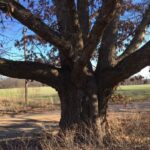“How about a catalpa tree?”
While catching up over lunch at a Mexican restaurant in Plymouth, my friend Jan from Ann Arbor (and my Beaver Island companion), suggested I consider planting a catalpa tree when the time comes in April. She described several individual catalpa trees that she looks for and admires in the area and mentioned their specific locations.
One pair of neighbors discover another pair
I immediately thought of the pair of catalpa trees my walking partner Jeanne and I discovered and identified–thanks to her gift of Trees, a Smithsonian Nature Guide–a few years ago.

Easy-to-identify trees
- First, we noticed the trees’ huge heart-shaped leaves on our early-morning walks. Catalpa leaves can be up to 12 inches from stem to stern.
- Late in the season, long after other flowering trees were done blooming, we were drawn to the trees by the sweet fragrance of their creamy-white orchid-like flowers, which feature flourishes of purple streaks and orangish-yellow spots from their ruffled petals into the throats of their trumpets. In this pair, only the tree on the right (above in the photo) blooms, at least since we’ve been paying attention.
- Finally, when the flowers are just a memory and the leaves have fallen, the long bean-like seed pods hang from the tree. These pods can be as long as 18 inches and hang onto the tree through the winter. As you can see above, as of March 6, they’re still hanging on. This fruit is apparently what gives the catalpa two of its nicknames: the “Cigar Tree” and the “Indian Bean.”

Two bits of history
A third “nickname” for the catalpa is the original name it was first given: “Catawba.” “Catalpa” is considered a misunderstanding of this original Cherokee name of the tree.
The southern variety of catalpa was “once widely planted for fenceposts.” Perhaps because, while its wood is “soft and light, [it is] surprisingly durable in contact with the soil.” That may explain why “in the Mississippi Valley, considerable plantations of catalpa” were maintained. And, why the wood of the catalpa was, for a time, used for railroad ties.
Imagining our pair’s history
Both of these trees appear to be old. I read that catalpa trees prefer “moist valley soils by streams.” Might this pair have, at one time, graced the banks (or less poetically, the floodplain) of the Red Run before the creek was corraled into a giant drainpipe and buried under Vinsetta’s boulevard?
Or, maybe being so cement-bound has just aged them before their time. I fervently hope the city leaves them alone.
A volunteer put up for adoption
I don’t even have one photo of the one other catalpa I have known, the little one I adopted in 2017. Neighbors around the block from me posted a photo on our Nextdoor site of the “volunteer” tree that was growing too close to their deck, asking if anyone wanted it. After getting to know and appreciate the pair of catalpas above, I did.
It was the end of a hot July, but the neighbors wanted it removed right away, so I went over and tried to carefully extract it out of dry, dry ground. Its small trunk was growing up snug to the deck, which made it difficult to get at its rootball from behind. Eventually, I had to call for help and resort to half digging and half pulling it free from rock-solid earth.
The Water Wagon
We planted the maybe two-foot-tall catalpa on the park lawn, where it would get some sun and have some room to grow, out from under the canopy of the other big trees in the yard. And, then we watered and watered and watered it. Our hoses, even all combined, wouldn’t stretch that far, so it was a matter of filling a Home Depot bucket with water, hoisting it up into the old family wagon, and transporting it down the driveway to the little three-foot tree. I wondered how many springs before it would bloom.
One of the things I did on my summer vacation
The week after the catalpa was transplanted, we left for a family reunion in Estes Park, Colorado. Lying in bed at night in a cabin on the banks of the Big Thompson River and listening to its babble and rush, it would not be an exaggeration to say I was praying that rain was falling in Michigan on the little tree.

But, when we arrived back home at the end of a ten-day Michigan August heat wave, it was too late for the water wagon to make a difference.
Lesson learned
I have no intention of planting a tree, any tree, ever again in summer. (Any more than I’d choose to plant another honey locust tree close to my house.)
What do you know about catalpa trees?
So I’m curious what you would think about the choice of a catalpa tree? Have you ever planted one or lived with one? Are there any other catalpa trees that you’ve noticed? Is there anything I should know about catalpa trees if I were to decide to plant one?
And . . .
Do you have a suggestion of another tree I should consider before deciding on what tree I’m going to plant at the end of April?
“. . . I will tell you how to plant a tree. First, dig a hole bigger than the tree requires so that it will have room enough to grow. Trim all broken branches or nearly broken branches and then put the tree in the middle of the hole. Then sprinkle rich dirt around the roots and cover up and stamp down the dirt all around. If it is in the growing season, water the tree when first planted but don’t keep it up. Artificial water is not as good as rain. . . .”
— From “arbor day” by evelyn glass of whittier [elementary school], 5a, in 1929, as reprinted in Royal Oak twigs and acorns, COMPILED BY DAVID G. PENNEY AND LOIS A. LANCE (ANN ARBOR, MI: SHERIDAN BOOKS, 2008)









Michigander, you need a buckeye tree!
Ha-ha. I’ve addressed your suggestion in my next posting, Susan, which will be posted soon.
Maureen, thank you for this article. We used to live in the house shown in back of these two trees. For years I’ve wondered what kind of trees they are and now I know! Mystery solved after 25 years!
Sad to report, Judy, that the City of Royal Oak removed both trees and redid the pedestrian walkway this spring. Was happy to notice the other day riding my bike by, however, that the trunk one of the trees, the one farthest west, has sent up shoots. It looks like a large bush has been planted on the site. Where its mate was growing is now cemented over, sadly. The trees were old, but I’d wish the powers-that-be had let them be. They bloomed last year, and it’s about the time they’d be blooming this year (although I’ve not seen a catalpa tree in bloom yet this year). Such a heavenly fragrance!